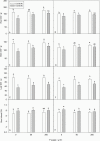Phosphorus application reduces aluminum toxicity in two Eucalyptus clones by increasing its accumulation in roots and decreasing its content in leaves
- PMID: 29324770
- PMCID: PMC5764327
- DOI: 10.1371/journal.pone.0190900
Phosphorus application reduces aluminum toxicity in two Eucalyptus clones by increasing its accumulation in roots and decreasing its content in leaves
Abstract
Under acidic conditions, aluminum (Al) toxicity is an important factor limiting plant productivity; however, the application of phosphorus (P) might alleviate the toxic effects of Al. In this study, seedlings of two vegetatively propagated Eucalyptus clones, E. grandis × E. urophylla 'G9' and E. grandis × E. urophylla 'DH32-29'were subjected to six treatments (two levels of Al stress and three levels of P). Under excessive Al stress, root Al content was higher, whereas shoot and leaf Al contents were lower with P application than those without P application. Further, Al accumulation was higher in the roots, but lower in the shoots and leaves of G9 than in those of DH32-29. The secretion of organic acids was higher under Al stress than under no Al stress. Further, under Al stress, the roots of G9 secreted more organic acids than those of DH32-29. With an increase in P supply, Al-induced secretion of organic acids from roots decreased. Under Al stress, some enzymes, including PEPC, CS, and IDH, played important roles in organic acid biosynthesis and degradation. Thus, our results indicate that P can reduce Al toxicity via the fixation of elemental Al in roots and restriction of its transport to stems and leaves, although P application cannot promote the secretion of organic acid anions. Further, the higher Al-resistance of G9 might be attributed to the higher Al accumulation in and organic acid anion secretion from roots and the lower levels of Al in leaves.
Conflict of interest statement
Figures





Similar articles
-
Metabolic acclimation supports higher aluminium-induced secretion of citrate and malate in an aluminium-tolerant hybrid clone of Eucalyptus.BMC Plant Biol. 2021 Jan 6;21(1):14. doi: 10.1186/s12870-020-02788-4. BMC Plant Biol. 2021. PMID: 33407145 Free PMC article.
-
Effect of Low pH and Aluminum Toxicity on the Photosynthetic Characteristics of Different Fast-Growing Eucalyptus Vegetatively Propagated Clones.PLoS One. 2015 Jun 19;10(6):e0130963. doi: 10.1371/journal.pone.0130963. eCollection 2015. PLoS One. 2015. PMID: 26090998 Free PMC article.
-
Mechanisms of aluminum-tolerance in two species of citrus: secretion of organic acid anions and immobilization of aluminum by phosphorus in roots.Plant Sci. 2011 Mar;180(3):521-30. doi: 10.1016/j.plantsci.2010.11.011. Epub 2010 Dec 4. Plant Sci. 2011. PMID: 21421400
-
Mechanisms and regulation of aluminum-induced secretion of organic acid anions from plant roots.J Zhejiang Univ Sci B. 2019 Jun;20(6):513-527. doi: 10.1631/jzus.B1900188. J Zhejiang Univ Sci B. 2019. PMID: 31090277 Free PMC article. Review.
-
[Organic acid secretion and its detoxification mechanism in plant roots under aluminum stress].Zhi Wu Sheng Li Yu Fen Zi Sheng Wu Xue Xue Bao. 2005 Apr;31(2):111-8. Zhi Wu Sheng Li Yu Fen Zi Sheng Wu Xue Xue Bao. 2005. PMID: 15840928 Review. Chinese.
Cited by
-
Metabolic acclimation supports higher aluminium-induced secretion of citrate and malate in an aluminium-tolerant hybrid clone of Eucalyptus.BMC Plant Biol. 2021 Jan 6;21(1):14. doi: 10.1186/s12870-020-02788-4. BMC Plant Biol. 2021. PMID: 33407145 Free PMC article.
-
Comparative stress physiological analysis of aluminium stress tolerance of indigenous maize (Zea mays L.) cultivars of eastern Himalaya.Heliyon. 2024 May 18;10(11):e31570. doi: 10.1016/j.heliyon.2024.e31570. eCollection 2024 Jun 15. Heliyon. 2024. PMID: 38828317 Free PMC article.
-
Importance of Mineral Nutrition for Mitigating Aluminum Toxicity in Plants on Acidic Soils: Current Status and Opportunities.Int J Mol Sci. 2018 Oct 8;19(10):3073. doi: 10.3390/ijms19103073. Int J Mol Sci. 2018. PMID: 30297682 Free PMC article. Review.
-
QTL mapping for aluminum tolerance in RIL population of soybean (Glycine max L.) by RAD sequencing.PLoS One. 2019 Oct 29;14(10):e0223674. doi: 10.1371/journal.pone.0223674. eCollection 2019. PLoS One. 2019. PMID: 31661499 Free PMC article.
-
Phosphorus Supplementation Enhances Growth and Antioxidant Defense Against Cadmium Stress in Cotton.Antioxidants (Basel). 2025 Jun 5;14(6):686. doi: 10.3390/antiox14060686. Antioxidants (Basel). 2025. PMID: 40563320 Free PMC article.
References
-
- Jansen S, Watanabe T, Dessein S, Robbrecht E, Smets E. 23–The evolution of aluminium accumulation in angiosperms. Evolution of Plant Physiology. 2004; 467–479.
-
- Pilon-Smits EA, Quinn CF, Tapken W, Malagoli M, Schiavon M. Physiological functions of beneficial elements. Curr Opin Plant Biol. 2009; 12(3): 267 doi: 10.1016/j.pbi.2009.04.009 - DOI - PubMed
-
- Osaki M, Watanabe T, Tadano T. Beneficial effect of aluminum on growth of plants adapted to low pH soils. Soil Sci Plant Nutr. 1997; 43(3): 551–563.
-
- R'Bia O, Horchani F, Smida I, Mejri M, Aschi-Smiti S. Aluminium phytotoxicity and plant acclimation to acidic soils. Int J Agr Res. 2011; 6(3): 194–208.
-
- Kochian LV, Piñeros MA, Hoekenga OA. The physiology, genetics and molecular biology of plant aluminum resistance and toxicity. Plant Soil. 2005; 274(1): 175–195.
Publication types
MeSH terms
Substances
LinkOut - more resources
Full Text Sources
Other Literature Sources

